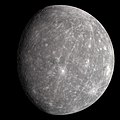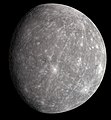Fichier:Mercury in true color.jpg
Apparence

Taille de cet aperçu : 600 × 600 pixels. Autres résolutions : 240 × 240 pixels | 480 × 480 pixels | 768 × 768 pixels | 1 040 × 1 040 pixels.
Fichier d’origine (1 040 × 1 040 pixels, taille du fichier : 408 kio, type MIME : image/jpeg)
Historique du fichier
Cliquer sur une date et heure pour voir le fichier tel qu'il était à ce moment-là.
| Date et heure | Vignette | Dimensions | Utilisateur | Commentaire | |
|---|---|---|---|---|---|
| actuel | 15 mai 2023 à 08:16 |  | 1 040 × 1 040 (408 kio) | CactiStaccingCrane | Reverted to version as of 10:42, 24 July 2022 (UTC) |
| 15 mai 2023 à 08:01 |  | 1 024 × 1 024 (837 kio) | CactiStaccingCrane | Manually merge the original monochrome image with the calibrated color image to eek out more resolution | |
| 24 juillet 2022 à 10:42 |  | 1 040 × 1 040 (408 kio) | JCP-JohnCarlo | Make this planet image center | |
| 24 juillet 2022 à 10:25 |  | 1 040 × 1 040 (710 kio) | JCP-JohnCarlo | Canvas image | |
| 3 novembre 2019 à 09:00 |  | 960 × 1 040 (865 kio) | Mirecki | User created page with UploadWizard |
Utilisation du fichier
La page suivante utilise ce fichier :
Usage global du fichier
Les autres wikis suivants utilisent ce fichier :
- Utilisation sur af.wikipedia.org
- Utilisation sur als.wikipedia.org
- Utilisation sur ar.wikibooks.org
- Utilisation sur as.wikipedia.org
- Utilisation sur be-tarask.wikipedia.org
- Utilisation sur beta.wikiversity.org
- Utilisation sur bn.wikipedia.org
- Utilisation sur bn.wikibooks.org
- Utilisation sur bo.wikipedia.org
- Utilisation sur br.wikipedia.org
- Utilisation sur ca.wikipedia.org
- Utilisation sur ceb.wikipedia.org
- Utilisation sur ckb.wiktionary.org
- Utilisation sur csb.wikipedia.org
- Utilisation sur cs.wikiversity.org
- Utilisation sur cv.wikipedia.org
- Utilisation sur cy.wikipedia.org
- Utilisation sur de.wikipedia.org
- Utilisation sur de.wiktionary.org
- Utilisation sur dty.wikipedia.org
- Utilisation sur dz.wikipedia.org
- Utilisation sur eml.wikipedia.org
- Utilisation sur en.wikipedia.org
- Mercury (planet)
- Terrestrial planet
- The Planets
- Timeline of discovery of Solar System planets and their moons
- List of Solar System objects by size
- List of gravitationally rounded objects of the Solar System
- User:Kwamikagami/sandbox
- NASA
- User:Kazkaskazkasako/Books/Physical sciences
- Talk:Mercury (planet)/Archive 3
- User:Nrco0e/Userboxes
- User:Applekle/sandbox
- Wikipedia:Userboxes/Location/Extraterrestrial
- Talk:The Planets/GA1
- User:Double sharp/Largest Solar System objects
- User:TomMasterReal
- User:Nrco0e/Userboxes/FavMercury
Voir davantage sur l’utilisation globale de ce fichier.


